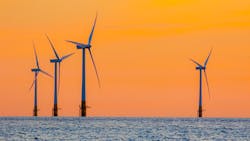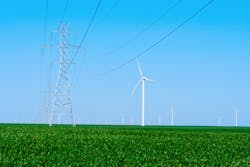Pathways to Transmission Investment and a U.S. Macro Grid
Reaching current U.S. decarbonization goals will require a doubling or tripling of the current transmission capacity to deliver that power to where it’s needed. Today, there are already over 1.3 terawatts of proposed wind, solar and battery energy storage storage projects in interconnection queues in the process of connecting to the grid. Whether due to a lack of consensus in regional transmission planning, challenges with permitting and/or cost recovery, the development of needed transmission capacity has lagged.
In addition, there is often a lack of understanding that a massive nationwide transmission expansion is required to cost-effectively transform the U.S. power system on a timeframe consistent with those goals. Coordination and cooperation could certainly be improved within and among regions across the country to better meet our national policy goals.
Integrating offshore wind into a nationally connected grid is also necessary to meet U.S. goals, particularly for the Northeast and Mid-Atlantic coastal regions where there are significant offshore wind resources and insufficient land available for wind development. East Coast states have already set goals to procure more than 30 GW of offshore wind, with state-specific decarbonization studies suggesting well over 100 GW of East Coast wind generation is needed by 2050. Moreover, with additional transmission capability, the generating potential of Canada’s wind and hydroelectric resources could provide dispatchable clean resources and grid flexibility for the Northeast, upper Midwest, and Pacific Northwest.
New York is fortunate to have access to plentiful renewable energy resources. In fact, Con Edison Transmission plans to invest over $1 billion over the next decade to develop electricity transmission to bring clean renewable energy from where it is produced to where it is needed to serve customers. Advocating a “transmission first” approach, Con Edison Transmission supports building transmission capacity before renewables are ready to simplify and streamline interconnection processes, recognizing that transmission development and siting generally takes longer than comparable processes for generation. Moreover, pre-building transmission including by the local utility can send better signals to prospective resources on suitable places to connect on the system.
Clean electricity generation is only possible with grid enhancement to enable reliable and resilient delivery systems. If we want to share our high-quality resources with neighboring regions, regional and interregional systems, including consideration of a macro grid concept, will work best. The benefits of expanded regional and interregional transmission are innumerable and vital to meet customers’ energy needs.
Numerous studies indicate that the wide-scale diversity of renewable resources, storage, demand-side management and other balancing resources significantly improve the quality of electricity supply. Several studies have shown that regional and interregional transmission provides many benefits. High voltage direct current (HVDC) technology may provide greater benefits when longer distances are needed because HVDC transmission has lower costs when transmitting electricity over hundreds of miles. Transmission across large regions, or across multiple regions can take advantage of HVDC for important economic and reliability benefits at a relatively low cost. HVDC is also a technology choice when moving electricity longer distances from offshore wind generation to land.
Numerous efforts are currently underway at the federal, regional, state, and local levels to improve coordination that could eventually lead to this undertaking. Despite that, connecting utility-scale renewable resources, distributed generation, storage, flexible demand management, and energy efficiency is not a task easily accomplished. We will need more work on how to design and build large-scale transmission within regions and to interconnect regions and resources. It will take time and require agreement and support from many stakeholders across large geographic areas. Yet it can be done. Together, step-by-step, with leadership from the utility sector and key regulatory bodies, we can create a strong foundation for the 21st century electricity infrastructure.
STUART NACHMIAS is president and chief executive officer of Con Edison Transmission, the company’s wholesale transmission business. Con Edison Transmission develops projects in the MISO, PJM, New York and New England regions. He also serves as Chair of the Board of Managers for New York Transco, a joint-venture transmission company comprised of Con Edison and New York State’s other investor-owned utilities. Nachmias holds an M.B.A. degree in finance from Baruch College, and earned a bachelor’s degree in both economics and psychology from Binghamton University. Nachmias is a board member of the Tenement Museum, which seeks to educate visitors about immigration experiences across cultures and ethnicities, and the Queens County Farm Museum, which has New York City’s largest remaining tract of undisturbed farmland dating back to 1697.


